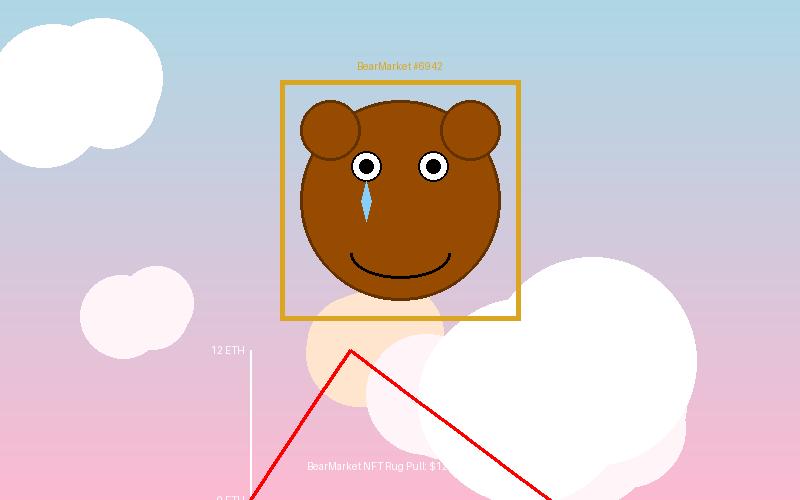Project Background
BearMarket NFT emerged in late January 2025 as one of the most hyped NFT collections of the year. The project marketed itself as "the first AI-generated, market-reactive NFT collection" that would supposedly change appearance based on cryptocurrency market conditions. The collection featured 10,000 unique bear characters with varying traits, accessories, and backgrounds that would allegedly transform depending on whether the market was bullish or bearish.
Project Website: https://bearmarketnft.io (now offline)
The project gained significant attention due to several factors:
1. Celebrity Endorsements: Several high-profile crypto influencers and celebrities promoted the project, including a famous rapper who claimed to have joined as a "creative advisor."
2. Innovative Concept: The idea of NFTs that changed based on market conditions was novel and appealing to traders who wanted to express their market sentiment through digital art.
3. Exclusive Community: The project created an aura of exclusivity with a gated Discord server that required verification and had over 250,000 members at its peak.
4. Roadmap Promises: The team promised extensive utility for holders, including access to a proprietary trading platform, revenue sharing from future collections, and integration with major metaverse projects.
The mint price was set at 0.5 ETH per NFT (approximately $1,230 at the time), and the entire collection sold out within 12 minutes of the public sale on February 15, 2025, raising approximately $12.3 million.
The Attack
Timeline of Events
January 25, 2025: BearMarket NFT project announced on Twitter with a teaser video showing the dynamic NFT concept.
January 28, 2025: Discord server launched with a whitelist application process that attracted over 150,000 applications in the first 48 hours.
February 5, 2025: Whitelist spots confirmed for 5,000 users who would get priority access to the mint.
February 10, 2025: Team released "sneak peeks" of the artwork and published a detailed whitepaper explaining the technology behind the market-reactive NFTs.
February 14, 2025: Whitelist mint began at 0.4 ETH per NFT, with 5,000 NFTs sold.
February 15, 2025 (14:00 UTC): Public mint launched at 0.5 ETH per NFT, with the remaining 5,000 NFTs selling out in 12 minutes.
February 15, 2025 (16:30 UTC): Trading opened on major NFT marketplaces with an initial floor price of 0.8 ETH.
February 16, 2025: Floor price reached a peak of 2.3 ETH amid heavy trading volume, much of which was later revealed to be wash trading by the team to create artificial demand.
February 17, 2025: Community members began reporting that the "market-reactive" feature was not working as promised, with NFTs remaining static regardless of market conditions.
February 18, 2025 (03:30 UTC): All funds (approximately 5,000 ETH) were withdrawn from the project's treasury wallet to multiple unknown addresses.
February 18, 2025 (04:15 UTC): The project's Discord server was deleted without warning.
February 18, 2025 (05:00 UTC): The project website went offline.
February 18, 2025 (06:30 UTC): All social media accounts associated with the project were either deleted or abandoned.
February 18, 2025 (10:00 UTC): Floor price collapsed to 0.05 ETH as holders panic-sold their now-worthless NFTs.
Technical Details
The BearMarket NFT rug pull was not a technical exploit of smart contract vulnerabilities but rather a deliberate scam from the beginning. However, there were several technical aspects to how the fraud was executed:
1. False Technical Claims: The project's whitepaper claimed that the NFTs contained special metadata that would interact with price oracles to change the artwork based on market conditions. This was technically feasible but was never actually implemented in the smart contract.
2. Static Metadata: Despite claims of dynamic, market-reactive NFTs, analysis of the smart contract revealed that all metadata was static and stored on centralized servers rather than on-chain.
3. Centralized Hosting: The NFT images were hosted on centralized servers rather than using decentralized storage solutions like IPFS, giving the team complete control over the artwork and allowing them to take it offline.
4. Wash Trading Bot: The team deployed sophisticated trading bots across multiple wallets to create artificial trading volume and drive up the floor price after the mint.
5. Treasury Control: The project's smart contract allowed the team to withdraw all funds without any timelock or multi-signature requirements, enabling them to drain the treasury instantly.
// Simplified representation of the BearMarket NFT contract
// Note: This is a reconstruction based on on-chain analysis
contract BearMarketNFT is ERC721, Ownable {
using Strings for uint256;
uint256 public constant MAX_SUPPLY = 10000;
uint256 public constant MINT_PRICE = 0.5 ether;
string private _baseTokenURI;
bool public mintingActive = false;
mapping(address => bool) public whitelisted;
constructor() ERC721("BearMarket NFT", "BEAR") {
_baseTokenURI = "https://api.bearmarketnft.io/metadata/";
}
function mint(uint256 quantity) external payable {
require(mintingActive, "Minting is not active");
require(totalSupply() + quantity <= MAX_SUPPLY, "Would exceed max supply");
require(msg.value >= MINT_PRICE * quantity, "Insufficient payment");
for (uint256 i = 0; i < quantity; i++) {
_safeMint(msg.sender, totalSupply() + 1);
}
}
function whitelistMint(uint256 quantity) external payable {
require(whitelisted[msg.sender], "Not whitelisted");
require(totalSupply() + quantity <= 5000, "Would exceed whitelist allocation");
require(msg.value >= 0.4 ether * quantity, "Insufficient payment");
for (uint256 i = 0; i < quantity; i++) {
_safeMint(msg.sender, totalSupply() + 1);
}
}
// No market reactivity implementation despite claims in the marketing
// Owner can withdraw all funds at any time with no restrictions
function withdrawAll() external onlyOwner {
payable(owner()).transfer(address(this).balance);
}
// Owner can change the metadata URI at any time
function setBaseURI(string memory newBaseURI) external onlyOwner {
_baseTokenURI = newBaseURI;
}
function _baseURI() internal view override returns (string memory) {
return _baseTokenURI;
}
}Addresses & Transactions
- BearMarket NFT Contract:
0x8Fc66bD9C877e3F20dc8b100E6D08C0d9D5c4A4A - Treasury Wallet:
0x3a1F984B6a2F1a8A4d2F5d4c3B2a1F984B6a2F1a - Primary Destination of Funds:
0x7Bd9C877e3F20dc8b100E6D08C0d9D5c4A4A8Fc6
The rug pull involved several key transactions:
1. The initial mint generated approximately 5,000 ETH (worth $12.3 million at the time) which was sent to the project's treasury wallet.
2. On February 18, 2025, at 03:30 UTC, the treasury wallet executed the withdrawAll() function, transferring all funds to the primary destination wallet.
3. From the primary destination, the funds were split across more than 20 different wallets in varying amounts, likely to complicate tracking efforts.
4. These funds were then further dispersed through multiple exchanges, both centralized and decentralized, with significant portions being converted to privacy coins like Monero.
Blockchain forensics firms have been tracking these transactions, but the sophisticated laundering techniques have made recovery extremely difficult.
Aftermath
Project Response
There was no official response from the BearMarket NFT team following the rug pull. All communication channels were deleted, and team members' social media accounts were either deleted or abandoned. The anonymous nature of the team meant that there were no real identities to hold accountable.
Several individuals who had promoted the project as influencers quickly distanced themselves, claiming they had been deceived about the project's legitimacy. Some even claimed their endorsements had been coerced or manipulated, though evidence suggested many had received significant compensation for their promotion.
Market Impact
The BearMarket NFT rug pull had several ripple effects in the NFT market:
1. Immediate Price Collapse: The floor price of BearMarket NFTs collapsed from 2.3 ETH to 0.05 ETH within hours of the rug pull being discovered.
2. Broader NFT Market Impact: The incident contributed to a general cooling in the NFT market, with trading volumes across major marketplaces declining by approximately 15% in the week following the rug pull.
3. Increased Scrutiny: NFT marketplaces implemented additional verification requirements for new collections, with OpenSea and Blur both announcing enhanced due diligence processes.
4. Influencer Backlash: The crypto community became more critical of influencer promotions, with several prominent figures facing significant reputation damage for their association with the project.
5. Regulatory Attention: The incident attracted attention from regulatory bodies, with the SEC citing it as an example of why greater oversight of the NFT market might be necessary.
Recovery Efforts
Recovery efforts have been largely community-driven and have had limited success:
1. Community Revival: A group of holders formed "BearMarket Survivors DAO" to attempt to salvage some value from the project.
2. Technical Resurrection: Community developers created a new smart contract that allowed holders to "wrap" their original BearMarket NFTs and receive new tokens with actual on-chain artwork stored on IPFS.
3. Legal Action: Several holders formed a class-action lawsuit against the identifiable promoters of the project, though the anonymous creators remained elusive.
4. Marketplace Support: Some NFT marketplaces flagged the collection as a scam but continued to allow trading for those who still wanted to buy or sell the NFTs.
5. Minimal Fund Recovery: Despite blockchain forensics efforts, less than 1% of the stolen funds have been recovered or frozen on centralized exchanges.
Analysis
Root Cause
The BearMarket NFT rug pull was a case of deliberate fraud rather than a technical vulnerability, but several factors enabled its success:
1. Hype-Driven Market: The NFT market's tendency to value hype and FOMO (Fear of Missing Out) over technical fundamentals created fertile ground for this type of scam.
2. Influencer Marketing: The project's heavy reliance on influencer marketing created an artificial sense of legitimacy and trustworthiness.
3. Technical Complexity: The promise of "market-reactive" NFTs involved technical concepts that many buyers didn't fully understand, making it easier to sell a non-functional product.
4. Anonymous Teams: The acceptance of anonymous teams in the NFT space removed accountability and made it easier for the perpetrators to disappear after the scam.
5. Inadequate Due Diligence: Marketplaces and buyers often failed to perform adequate due diligence on the technical claims and team backgrounds of new NFT projects.
Security Lessons
The BearMarket NFT incident offers several important lessons for the NFT community:
1. DYOR (Do Your Own Research): Buyers should thoroughly research projects, verify technical claims, and be skeptical of hype and influencer endorsements.
2. Demand Transparency: Prefer projects with doxxed (publicly identified) teams and clear, verifiable roadmaps.
3. Verify Metadata Storage: Check where NFT metadata and artwork are stored. On-chain or IPFS storage is generally more secure than centralized servers.
4. Be Wary of Wash Trading: High trading volume shortly after mint can be a sign of artificial manipulation.
5. Question Utility Promises: Be skeptical of projects promising extensive future utility that seems unrealistic or overly ambitious.
Red Flags
In retrospect, BearMarket NFT exhibited numerous red flags:
1. The team was completely anonymous.
2. The technical claims about market reactivity were vague and lacked detailed implementation plans.
3. The project relied heavily on paid promotions from influencers with questionable track records.
4. The smart contract allowed the owner to withdraw all funds instantly.
5. The artwork was hosted on centralized servers.
Suspected Perpetrator
The identity of the BearMarket NFT creators remains unknown. They operated under pseudonyms and used various techniques to obscure their real identities. The attack was well-planned and executed, suggesting a group with experience in both NFT marketing and cryptocurrency laundering.
Blockchain analysis has not definitively linked the attack to any known groups, but the methods used (influencer marketing, hype generation, rapid fund withdrawal, and sophisticated laundering) are characteristic of organized scam operations targeting the NFT space.
Media & Community Reaction
The reaction to the BearMarket NFT rug pull was predominantly negative:
1. Widespread Anger: Holders expressed significant anger towards the anonymous team and the influencers who promoted the project.
2. Calls for Accountability: There were strong calls for NFT marketplaces and influencers to take more responsibility for vetting projects.
3. Damage to NFT Reputation: The incident further damaged the reputation of the NFT space, reinforcing perceptions of it being rife with scams.
4. Memes: The community created memes mocking the project, the influencers, and the concept of "market-reactive" NFTs.


